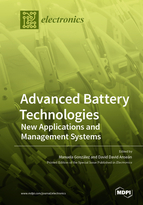Advanced Battery Technologies: New Applications and Management Systems
A special issue of Electronics (ISSN 2079-9292). This special issue belongs to the section "Power Electronics".
Deadline for manuscript submissions: closed (31 December 2020) | Viewed by 54525
Special Issue Editors
Interests: Li-ion battery technologies; battery management systems (BMS); battery fast-charging; battery diagnosis and prognosis
Special Issues, Collections and Topics in MDPI journals
Interests: lithium-ion battery testing and characterization; lithium-ion battery degradation mechanisms via non-invasive methods; incremental capacity and peak area analyses; mechanistic battery modeling; battery lithium plating; battery fast charging; battery diagnosis and prognosis; battery state of charge and state of health determination methods
Special Issues, Collections and Topics in MDPI journals
Special Issue Information
Dear Colleagues,
In recent years, the high performance of new battery technologies combined with the continuous improvement of their cost-competitiveness have been key to the development of an exciting range of applications in both commercial and industrial fields. Some examples of the broad spectrum of battery applications include: biomedical devices and portable electronics (cell phones and laptops, power tools, drones and electronic instrumentation), sustainable transportation (electric and hybrid aircraft, land and water vehicles) and stationary applications (smart grids, energy storage from renewable energy generation, telecommunications and uninterruptible power supplies).
However, battery systems are complex and still face problems mainly related to degradation, safety and management. The diagnosis of battery status (State-of-Charge and State-of-Heath) is necessary to determine the optimal charging/discharging strategy, avoiding hazardous operation conditions and extending battery life. Other main issue is the minimization of recharging time, which requires the implementation of reliable and efficient fast-charge methods. Therefore, the successful development of new applications with advanced battery technologies is only possible with a parallel development of electronic circuits dedicated to battery protection and management.
The main aim of this Special Issue is to seek high-quality submissions that highlight emerging applications with advanced battery technologies, address recent breakthroughs in the design of Battery Management Systems (BMS), efficient battery fast-chargers, smart batteries, and integration of Battery Energy Storage Systems (BESS) in electromobility and stationary applications.
The topics of interest include, but are not limited to:
- Disruptive Battery Technologies
- Advanced Battery Management Systems (BMS)
- Efficient Battery Fast-Chargers
- Smart Batteries with New Functionalities
- Innovative Control Strategies for Battery Energy Storage Systems (BESS): Electromobility and Stationary Applications
Prof. Dr. Manuela González
Prof. Dr. David Anseán
Guest Editor
Manuscript Submission Information
Manuscripts should be submitted online at www.mdpi.com by registering and logging in to this website. Once you are registered, click here to go to the submission form. Manuscripts can be submitted until the deadline. All submissions that pass pre-check are peer-reviewed. Accepted papers will be published continuously in the journal (as soon as accepted) and will be listed together on the special issue website. Research articles, review articles as well as short communications are invited. For planned papers, a title and short abstract (about 100 words) can be sent to the Editorial Office for announcement on this website.
Submitted manuscripts should not have been published previously, nor be under consideration for publication elsewhere (except conference proceedings papers). All manuscripts are thoroughly refereed through a single-blind peer-review process. A guide for authors and other relevant information for submission of manuscripts is available on the Instructions for Authors page. Electronics is an international peer-reviewed open access semimonthly journal published by MDPI.
Please visit the Instructions for Authors page before submitting a manuscript. The Article Processing Charge (APC) for publication in this open access journal is 2400 CHF (Swiss Francs). Submitted papers should be well formatted and use good English. Authors may use MDPI's English editing service prior to publication or during author revisions.
Keywords
- Disruptive Battery Technologies
- Advanced Battery Management Systems (BMS)
- Efficient Battery Fast-Chargers
- Smart Batteries with New Functionalities
- Innovative Control Strategies for Battery Energy Storage Systems (BESS): Electromobility and Stationary Applications







